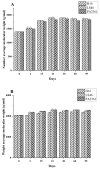Bacterial Degradation of Low-Density Polyethylene Preferentially Targets the Amorphous Regions of the Polymer
- PMID: 39458693
- PMCID: PMC11511126
- DOI: 10.3390/polym16202865
Bacterial Degradation of Low-Density Polyethylene Preferentially Targets the Amorphous Regions of the Polymer
Abstract
Low-density polyethylene (LDPE) is among the most abundant synthetic plastics in the world, contributing significantly to the plastic waste accumulation problem. A variety of microorganisms, such as Cupriavidus necator H16, Pseudomonas putida LS46, and Pseudomonas chlororaphis PA2361, can form biofilms on the surface of LDPE polymers and cause damage to the exterior structure. However, the damage is not extensive and complete degradation has not been achieved. The changes in polymer structure were analyzed using Time-domain Nuclear Magnetic Resonance (TD-NMR), High-Temperature Size-Exclusion Chromatography (HT-SEC), Differential Scanning Calorimetry (DSC), and Gas Chromatography with a Flame Ionization Detector (GC-FID). Limited degradation of the LDPE powder was seen in the first 30 days of incubation with the bacteria. Degradation can be seen in the LDPE weight loss percentage, LDPE degradation products in the supernatant, and the decrease in the percentage of amorphous regions (from >47% to 40%). The changes in weight-average molar mass (Mw), number-average molar mass (Mn), and the dispersity ratio (Đ) indicate that the low-molar mass fractions of the LDPE were preferentially degraded. The results here confirmed that LDPE degradation is heavily dependent on the presence of amorphous content and that only the amorphous content was degraded via bacterial enzymatic action.
Keywords: LDPE; biodegradation; low-density polyethylene; microbial degradation; polymer structure.
Conflict of interest statement
Authors Everett Kysor and Olaf Kohlmann were employed by LexMar Global Inc. The remaining authors declare that the research was conducted in the absence of any commercial or financial relationships that could be construed as a potential conflict of interest.
Figures








References
-
- Jaganmohan M. Plastic Production Forecast Worldwide 2025–2050. 2024. [(accessed on 17 July 2024)]. Available online: https://www.statista.com/statistics/664906/plastics-production-volume-fo...
-
- Deloitte Economic Study of the Canadian Plastic Industry, Markets and Waste. 2019. [(accessed on 17 July 2024)]. Available online: https://publications.gc.ca/collections/collection_2019/eccc/En4-366-1-20....
-
- AgileIntel Research (ChemIntel360) Global Plastic Market Size 2023–2033. July 2023. [(accessed on 17 July 2024)]. Available online: https://www.statista.com/statistics/1245162/polyethylene-market-volume-w...
Grants and funding
LinkOut - more resources
Full Text Sources
Miscellaneous

